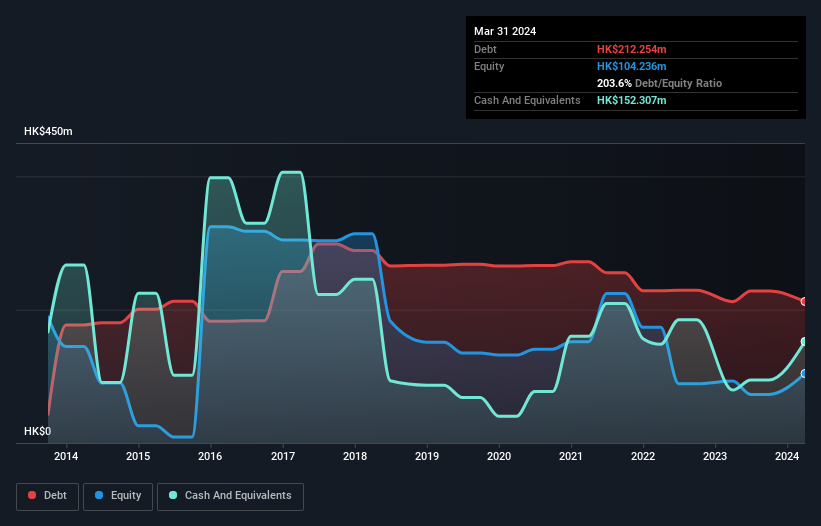
Legendary fund manager Li Lu (who Charlie Munger backed) once said, 'The biggest investment risk is not the volatility of prices, but whether you will suffer a permanent loss of capital.' So it might be obvious that you need to consider debt, when you think about how risky any given stock is, because too much debt can sink a company. Importantly, Green Economy Development Limited (HKG:1315) does carry debt. But the real question is whether this debt is making the company risky.
What Risk Does Debt Bring?
Debt is a tool to help businesses grow, but if a business is incapable of paying off its lenders, then it exists at their mercy. In the worst case scenario, a company can go bankrupt if it cannot pay its creditors. However, a more usual (but still expensive) situation is where a company must dilute shareholders at a cheap share price simply to get debt under control. Having said that, the most common situation is where a company manages its debt reasonably well - and to its own advantage. The first step when considering a company's debt levels is to consider its cash and debt together.
See our latest analysis for Green Economy Development
How Much Debt Does Green Economy Development Carry?
As you can see below, Green Economy Development had HK$212.3m of debt, at March 2024, which is about the same as the year before. You can click the chart for greater detail. On the flip side, it has HK$152.3m in cash leading to net debt of about HK$59.9m.

A Look At Green Economy Development's Liabilities
The latest balance sheet data shows that Green Economy Development had liabilities of HK$469.7m due within a year, and liabilities of HK$105.9m falling due after that. Offsetting this, it had HK$152.3m in cash and HK$295.4m in receivables that were due within 12 months. So its liabilities outweigh the sum of its cash and (near-term) receivables by HK$127.9m.
This deficit casts a shadow over the HK$59.1m company, like a colossus towering over mere mortals. So we definitely think shareholders need to watch this one closely. After all, Green Economy Development would likely require a major re-capitalisation if it had to pay its creditors today.
We use two main ratios to inform us about debt levels relative to earnings. The first is net debt divided by earnings before interest, tax, depreciation, and amortization (EBITDA), while the second is how many times its earnings before interest and tax (EBIT) covers its interest expense (or its interest cover, for short). This way, we consider both the absolute quantum of the debt, as well as the interest rates paid on it.
Green Economy Development has a very low debt to EBITDA ratio of 1.5 so it is strange to see weak interest coverage, with last year's EBIT being only 2.3 times the interest expense. So while we're not necessarily alarmed we think that its debt is far from trivial. Notably, Green Economy Development made a loss at the EBIT level, last year, but improved that to positive EBIT of HK$40m in the last twelve months. There's no doubt that we learn most about debt from the balance sheet. But you can't view debt in total isolation; since Green Economy Development will need earnings to service that debt. So when considering debt, it's definitely worth looking at the earnings trend. Click here for an interactive snapshot.
Finally, a business needs free cash flow to pay off debt; accounting profits just don't cut it. So it is important to check how much of its earnings before interest and tax (EBIT) converts to actual free cash flow. Happily for any shareholders, Green Economy Development actually produced more free cash flow than EBIT over the last year. There's nothing better than incoming cash when it comes to staying in your lenders' good graces.
Our View
We'd go so far as to say Green Economy Development's level of total liabilities was disappointing. But at least it's pretty decent at converting EBIT to free cash flow; that's encouraging. Looking at the balance sheet and taking into account all these factors, we do believe that debt is making Green Economy Development stock a bit risky. That's not necessarily a bad thing, but we'd generally feel more comfortable with less leverage. The balance sheet is clearly the area to focus on when you are analysing debt. However, not all investment risk resides within the balance sheet - far from it. We've identified 4 warning signs with Green Economy Development (at least 3 which are a bit concerning) , and understanding them should be part of your investment process.
If you're interested in investing in businesses that can grow profits without the burden of debt, then check out this free list of growing businesses that have net cash on the balance sheet.
Have feedback on this article? Concerned about the content? Get in touch with us directly. Alternatively, email editorial-team (at) simplywallst.com.
This article by Simply Wall St is general in nature. We provide commentary based on historical data and analyst forecasts only using an unbiased methodology and our articles are not intended to be financial advice. It does not constitute a recommendation to buy or sell any stock, and does not take account of your objectives, or your financial situation. We aim to bring you long-term focused analysis driven by fundamental data. Note that our analysis may not factor in the latest price-sensitive company announcements or qualitative material. Simply Wall St has no position in any stocks mentioned.